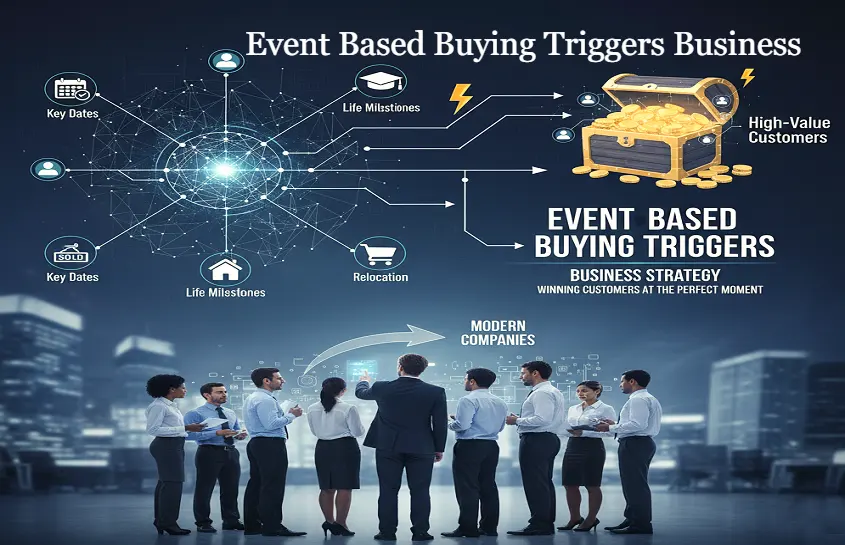In business, timing is often the difference between a conversation that dies in a cold inbox and a deal that transforms your quarterly revenue. While most marketing and sales teams talk about targeting, nurturing, or segmenting, the companies that consistently outperform their competitors rely on something more precise: event based buying triggers business strategy.
In simpler terms, this approach helps your business identify exact moments when a potential customer becomes more likely to buy — not because you convinced them, but because something changed in their world. A new executive joins. A company receives funding. A business expands. A merger happens. A new law affects their industry. These events shake existing systems, create pressure, and open the door to new solutions.
When you understand and act on these moments, you stop chasing uninterested leads and instead build a pipeline full of prospects who are already receptive. This article explains how event based buying triggers business strategies work, why they’re becoming essential in B2B sales, and how your company can use them to secure more opportunities with less effort.
What Are Event-Based Buying Triggers?
Event-based buying triggers are external signals that suggest a company may soon purchase a product or service. They reveal a shift — financial, operational, strategic, or internal — that makes the business more open to change.
These triggers are not random. They reflect business realities:
- A new leader wants new tools.
- Fresh investment demands rapid scaling.
- Expansion creates logistical challenges.
- Compliance requirements force new spending.
- Growth exposes system weaknesses.
When these moments happen, companies enter what marketers call the “window of intent.” That window may last days or weeks — but during that period, outreach is significantly more effective.
This is why businesses using event based buying triggers succeed faster: they align outreach with timing, which naturally increases relevance.
Why Event Based Buying Triggers Business Strategy Outperforms Traditional Marketing
Most businesses still rely on volume: more emails, more ads, more cold calls. But modern buyers tune those out. What they respond to is timing and relevance.
Here’s why an event-triggered strategy works far better:
1. Buyers respond when the timing is right
If a company just hired a new CTO, launched a security audit, or opened a new office — they are already evaluating tools. A well-timed message fits into their current agenda.
2. Trigger-based outreach feels personal, not spammy
When you say, “Congratulations on your Series A funding — I imagine scaling operations is at the top of your list,”
you sound informed and aligned.
3. Sales cycles shorten dramatically
Reaching companies during a change reduces resistance. They’re already in decision mode.
4. Higher-quality leads with real intent
Not all leads want to buy. But leads experiencing a trigger event need to buy something soon — if not from you, then from someone else.
5. Competitors who rely on cold outreach fall behind
Small and mid-sized businesses using event-triggered intelligence close deals that larger, slower competitors miss.
Business Events That Trigger Buying Decisions
If you want to implement this strategy, start by understanding the most valuable triggers. Below is a business-centric breakdown of common triggers that ignite buying intent.
1. Leadership Changes
A new CEO, CFO, CMO, CTO, or department head typically reviews existing tools and vendors within their first 90 days. They want improvements, new strategies, and systems that align with their vision.
Opportunity for:
software vendors, consultants, HR services, IT providers, marketing agencies, security platforms.
2. Funding Rounds (Seed, Series A, B, C…)
Companies with newly raised capital spend heavily on growth, hiring, tools, and modernization.
Opportunity for:
SaaS platforms, hiring tools, cybersecurity companies, infrastructure, analytics, onboarding tools.
3. Rapid Hiring or Workforce Expansion
Fast hiring indicates operational scaling challenges.
Opportunity for:
HR tech, background check providers, training platforms, workforce management tools, payroll solutions.
4. Mergers & Acquisitions
M&A events create chaos — and chaos requires new systems.
Opportunity for:
ERP systems, CRM vendors, consultants, legal services, IT providers, cloud infrastructure, cybersecurity.
5. New Office or Market Expansion
Opening in a new location means new suppliers, tools, partnerships, logistics, and compliance needs.
Opportunity for:
IT setup firms, office suppliers, facilities management, HR consultants, marketing agencies, logistics companies.
6. Technology Failures or Upgrades
If a company publicly deals with outages, data breaches, or service interruptions, they will explore alternative solutions.
Opportunity for:
cloud providers, backup solutions, cybersecurity firms, infrastructure management tools.
7. Industry Regulation Changes
Legal changes force companies to adopt tools they never needed before — often fast.
Opportunity for:
compliance solutions, legal advisors, audit services, documentation tools, cybersecurity.
8. Major Client Wins or New Product Launches
When a company wins a large contract or prepares a major launch, they need additional resources and systems.
Opportunity for:
sales tools, CRM upgrades, supply chain systems, marketing partners, customer support platforms.
9. Declining Performance or Leadership Shakeups
If business performance drops, companies often overhaul processes and bring in external help.
Opportunity for:
consultants, outsourcing companies, cost-reduction solutions, analytics tools.
Read More: Forging Industry Forcast for India: New Horizons for Metal Manufacturing
How to Build an Event Based Buying Triggers Business Strategy

Now let’s turn this concept into a practical, repeatable, business-ready process.
Step 1: Identify Your ICP (Ideal Customer Profile)
Before tracking any triggers, define:
- industry
- company size
- annual revenue
- geography
- technologies used
- challenges your product solves
This prevents wasting time on irrelevant events.
Step 2: Decide Which Triggers Matter Most for Your Offering
For example:
- If you sell HR software: hiring spikes and new HR leaders matter.
- If you sell cybersecurity: breaches, new CTOs, and compliance changes matter.
- If you sell marketing services: funding rounds and product launches matter.
Map your product to corresponding triggers.
Step 3: Set Up Trigger Monitoring
Use a combination of tools and manual tracking:
- LinkedIn announcements
- Company press releases
- Job postings
- Funding databases
- Google Alerts
- Industry news sites
- Quarterly earnings reports
Your goal: detect triggers quickly.
Step 4: Build Trigger-Specific Messaging
Every trigger requires a different angle.
Example — Funding Round:
“Congrats on your Series B funding — companies at this stage often evaluate scalable automation tools. Are you exploring new systems yet?”
Example — New CTO:
“Welcome to your new role — many new technology leaders evaluate their stack in the first months. Happy to share insights.”
This approach feels thoughtful, not robotic.
Step 5: Act Fast
Event windows do not last long. Strike while the moment is fresh.
Step 6: Prioritize Based on Trigger Strength
Rank events:
- High-value triggers: funding, new executive, M&A
- Medium triggers: expansions, hiring trends, new products
- Low triggers: minor announcements, small collaborations
This helps focus your sales efforts.
Step 7: Follow Up with Value, Not Pressure
Do not sell immediately. Offer:
- case studies
- benchmarks
- industry insights
- strategy breakdowns
- short audits
Helpful businesses win more deals.
Read More: Telecom Expense Management Companies: How Businesses Regain Control of Their Communication Costs
Real-World Example: How Event-Based Buying Transforms B2B Sales

Let’s say you sell enterprise cybersecurity software.
A mid-sized tech company announces:
- They hired a new CTO
- They are expanding into Europe
- They recently experienced a minor data leak
This combination of triggers creates an ideal scenario.
Here’s how you act:
Day 1:
Send a personalized email referencing the new CTO appointment and the expansion.
Offer a free cybersecurity review for new markets.
Day 3:
Share a case study of another company with similar expansion.
Day 7:
Connect on LinkedIn with the CTO and relevant engineering leads.
Day 10:
Provide insights on compliance requirements in the European market.
Within weeks, you secure a meeting not because you pushed hard — but because timing matched their internal changes.
This is event based buying triggers business strategy in real life.
How Businesses Misuse Trigger Strategies (and What to Avoid)
Trigger-based approaches fail when companies treat them like shortcuts.
Here are mistakes to avoid:
- Reaching out too late: By then, the buyer is already deep in vendor selection.
- Sending generic outreach: If your message doesn’t reference the trigger, the opportunity is wasted.
- Confusing minor events with major triggers: Not every announcement equals buying intent.
- Being pushy: The key is alignment, not aggressive selling.
- Relying only on automation: Trigger strategies must feel human — not templated.
Measuring Success: What KPIs Reveal Your Trigger Strategy Is Working
Track the following:
- Reply rates to trigger-based outreach
- Opportunity generation within 30 days of an event
- Sales cycle duration
- Close rate of event-triggered opportunities
- Cost per acquisition vs non-trigger campaigns
Businesses that master this strategy report:
- 2–5× higher reply rates
- 30–50% faster sales cycles
- stronger quality pipelines
These outcomes alone justify adopting the event based buying triggers business model.
Future of Event-Based Buying Triggers in B2B
As automation, AI-driven insights, and business intelligence platforms evolve, trigger-tracking will become even more precise. You’ll soon see:
- predictive triggers (events that forecast buyer intent)
- multi-event scoring models
- real-time sales alerts
- dynamic messaging templates
- intent signals combined with behavioral data
In other words, the future of B2B sales will lean heavily toward timing — not just targeting.
Conclusion
Businesses succeed when they understand people, patterns, and most importantly, moments. An event based buying triggers business strategy gives companies a powerful edge by connecting with prospects at the exact time they need help, instead of hoping for interest someday.
It is smart. It is efficient. And it reflects how modern business decisions are made.
Whether you’re a startup founder, a B2B marketer, or a seasoned sales leader, learning to spot triggers — and act on them — can redefine the quality of your pipeline and transform your revenue trajectory.
FAQs About Event Based Buying Triggers Business
Q: What does “event based buying triggers business” actually mean?
A: It simply refers to identifying key events happening inside a target company — such as leadership changes, funding rounds, expansions, or product launches — that indicate they may be ready to buy. Instead of reaching out randomly, you act when a real business event increases buying intent.
Q: Why do trigger events make companies more likely to purchase?
A: Trigger events often introduce new goals, challenges or pressure. A new executive may want updated tools. A funding round may demand scaling. Compliance changes may force investment. These moments create urgency, making companies more open to new vendors.
Q: How quickly should a business act on a buying trigger?
A: Timing is everything. The first 24–72 hours after a trigger event are the most valuable. Buyers are already thinking about solutions, and reaching out early positions your company as proactive and attentive.
Q: What are the most powerful buying triggers in B2B sales?
A: The strongest triggers include new leadership hires, funding announcements, mergers, rapid hiring, expansion into new markets, and major product launches. These events create immediate operational needs and budget shifts.
Q: How do I find trigger events for my target companies?
A: You can monitor press releases, LinkedIn changes, job postings, funding news, regulatory updates, earnings reports, and industry publications. Some businesses also use sales intelligence tools, but manual tracking works fine when done consistently.
Q: Does every event guarantee a buying opportunity?
A: No. Some events signal mild interest; others indicate strong intent. The key is learning which triggers align with your product. For example, funding often benefits SaaS companies, while regulatory changes may be more valuable for compliance platforms.
Q: How do I personalize outreach based on a trigger event?
A: Mention the event directly, connect it to a real challenge, and offer a helpful insight rather than a sales pitch. Example:
“Congrats on opening your new office — companies expanding into new regions often face onboarding challenges. Here’s a guide others find helpful.”
Q: Can small businesses use trigger-based selling?
A: Absolutely. In fact, small teams benefit even more because it reduces wasted effort. Instead of cold contacting 500 companies, your team targets 20 high-intent prospects experiencing real change.
Q: How do buying triggers impact the sales cycle?
A: Trigger-based outreach typically shortens the sales cycle significantly. Since the buyer is already evaluating solutions, conversations progress faster, objections are fewer, and decisions are made more confidently.
Q: What’s the biggest mistake companies make when using buying triggers?
A: Using generic outreach. If you don’t connect your message to the specific event, the prospect won’t feel understood. Trigger-based selling works only when the timing and message align naturally.

